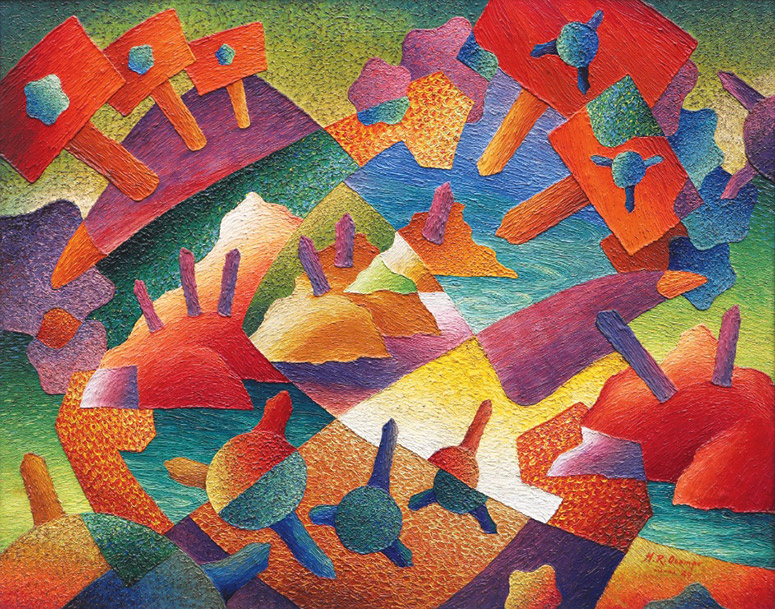A world record: Ifugao bench fetches P22 million at auction
A 13-foot-long hagabi, otherwise known as an “Ifugao Prestige Bench,” made history at the recent León Gallery Kingly Treasures auction last Nov. 28. It soared to a world record of P22 million, inclusive of buyer’s premium, for a Filipino artifact. At nearly half a million dollars or $460,000, this is the highest price paid for a Philippine indigenous item. It broke the previous world record made in an international auction in 2013 for the sale of a bulul or Ifugao figure that brought in $280,000.
Ironically, it was the first time such a work would reach such heights in the predominantly Manila-centric Philippine auction market that reveres old masters such as Juan Luna and Felix Resurreccion Hidalgo, Fernando Amorsolo and the mid-century moderns such as Jose Joya and Hernando R. Ocampo.
(Incidentally, an H.R. Ocampo, titled “Tempo Rubato (Time Robbed),” struck gold and established another world record for the artist at P37.4 million. This beauty was from the personal collection of the business titan Don Eugenio “Geny” Lopez Jr. However, the triumph of this 1949 masterpiece was more or less expected; the results for the hagabi was a total — although welcome — shock to the market.)

“You think you have everything pegged and then, once in a while, something totally unpredictable happens. Such is the case for the hagabi,” said one seasoned observer.
“It’s a proud day for all of the Philippines to be so recognized in the world of ethnic arts,” said another auction aficionado. “This news will spread like wildfire in the international tribal arts collector community. They will go nuts!”
The hagabi is a measure of a man’s wealth among the northern tribe of the Ifugao and is a necessary accoutrement for the members of the kadangyan or highest caste. That wealth is measured not only in the ownership of rice terraces — considered more eternal than mere money — but also in the willingness to share these riches with the rest of the community. The hagabi is therefore the pinnacle of this trait since it entails years of deliberate profit-sharing among the people of one’s village. From the selection of the right tree, to its chopping and hauling, carving and ultimate decoration with a powerful spirit animal with large ears and a snout, it is a final expression of one’s do-gooding to the collective. (Scholars variously name the hagabi’s mythical creature as a pig or a carabao, both favored as sacrifices in Ifugao rituals.)

There are lavish feasts for every part of its creation, each part running up to an entire month of generous meals and the doling out of rice as well as rice wine. In fact, the making of a hagabi is deliberately timed with the leanest part of the year or when crops are at their worst to tide over as many of one’s fellow villagers, the poorest of the poor, as possible.
This record-making hagabi was originally in a European collection and made its way back to its Philippine homeland through the antiques dealer Osmundo Esguerra who, in his lifetime, was acknowledged as an expert in Filipino wood artifacts. It dates from the late 19th century.
In fact, a second piece of furniture, the Buencamino Aparador, was likewise rated by Esguerra as one of the most exquisite of its kind. The aparador or wardrobe once belonged to Doña Petrona Siojo de Buencamino whose initials are traced in bone inlay on the armoire’s crown. She was famous not only as one of the matriarchs of the moneyed enclave of San Miguel de Mayumo in Bulacan, but also as the mother of one of General Emilio Aguinaldo’s advisers, Don Felipe.

The stately cabinet made a strong showing at P10 million. The all-time record for 19th-century Ilustrado furniture, however, remains unbroken for the Tinio-Gabaldon Aparador, which raked in P16 million in 2015. Don Isauro Gabaldon was famous as Philippine Resident Commissioner in Washington, DC and it was thanks to a bill he later authored, as a senator, that the school buildings in the style bearing his name were established across the country.
Both auction numbers, however, are below the current record reached by the hagabi. Imagine, if you will, a kind of list of the Philippines’ richest men, not by the amount of assets they have in their name, but how much they gave to charity in the middle of the worst possible crisis, when their own fortunes would be sorely tried. Thus, the hagabi not only establishes the worth of Filipino indigenous art but also the value of a truly Filipino part of its spirit: a generosity worthy of any gentlefolk in the world. It’s something worth honoring in this time of the pandemic.
Banner photo: This P22 million hagabi, a symbol of the Filipino spirit, holds auction record for Philippine tribal art in the world.


